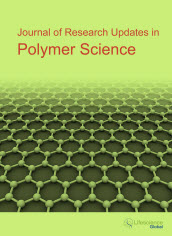jrups
Abstract : Study and Characterization of Polyaniline at Various Doping of LiCl wt.% Using Electrical Measurements and XRF Analysis
|
|
Abstract: Polyaniline PANI samples were synthesized via chemical polymerization method. The mechanism of charge transport in these composites has been studies by measuring the DC conductivity at various lithium chloride LiCl wt.%. It shows that their activation energy decreases with increasing LiCl concentration and thus, the conductivity increases at 15 %wt. In addition, X-ray Fluorescence XRF was used to analysis the elements of PANI regarding to LiCl concentration. The elements positively detected by the XRF are Cl, Kr, SO3, Al2O3, SiO2, and ZrO2. The XRF data show a relative systematic error typically independent of the concentration.The accuracy is determined by comparing the XRF data with various LiCl wt.%. Keywords: PANI, X-ray Fluorescence, conductivity, lithium chloride, activation energy.Download Full Article |
Abstract : Effect of Acid-Hydrolyzed Thermoplastic Starch on the Mechanical, Thermal and Morphological Properties of Polyethylene Based Composites
|
|
Abstract: The effect of the addition of hydrolyzed thermoplastic maize starch on the physico mechanical properties of low-density polyethylene (LDPE)-based composites was studied. Acid-hydrolyzed native starch was thermoplasticized using 15 and 30% glycerol in weight relative to starch, after which the LDPE/thermoplastic starch (TPS) composites were prepared at TPS concentrations of 10, 25, and 50%. According to the results of Raman spectroscopy, the appearance of a new band at 756 cm-1 was observed, and it was attributed to the hydrolysis process and associated with the C-C-O vibrational modes of the glycosidic bond. The addition of both native and polyethylene hydrolyzed TPS reduced the Young’s modulus of the composites; but the reduction was greater for those containing native starch. Both the maximum stress and deformation decreased to a greater degree for the composites with hydrolyzed TPS. The composites containing TPS prepared with 15% glycerol exhibited a higher Young’s modulus compared to those with LDPE, although they exhibited fragile behavior. The degree of matrix crystallinity increased with the addition of TPS and showed the largest increase when TPS 50% hydrolyzed by weight was added, showing an increase of 35%. It was observed that the size of the TPS particles, both native and hydrolyzed, increased in size as the concentration of TPS in the matrix increased. The size of the hydrolyzed TPS particles was greater than that of the native TPS particles, and in the case the of the hydrolyzed TPS particles, some exhibited an ellipsoidal and/or fibrillar morphology. Keywords: Chemical modifications, LDPE, hydrolyzed thermoplastic starch.Download Full Article |
Abstract : Assembly of Ordered Polystyrene Nanoparticles on Self-Assembled Monolayers
|
|
Abstract: Spontaneous assembly of nanoparticles onto a surface is a promising bottom-up concept for the fabrication of new functional materials that can be used for various applications in the nanotechnology. In this paper, we describe a system based on gold/polystyrene (Au/PS) Janus particles arranged onto Au self-assembled monolayer (SAM) of 1-dodecanthiol (NDA). The micro-size Au/PS Janus particles are self-assembled onto Au surface and are dissolved into polystyrene (PS) nanoparticles. The SAM of NDA plays two different roles; it dissolves the original Au/PS Janus particles and organizes the PS nanoparticles onto the Au surface. Overall, our proposed method for the assembly of large-scale area nanoparticles can be extended for further uses in the surface science. Keywords: Self-assembled monolayer, Polymeric nanoparticles, Spontaneous arrangement, Polystyrene, Surface chemistry, Janus particles.Download Full Article |
Abstract : Synthesis and Characterization of Electrically Conducting Polyaniline Doped with Glacial Acetic Acid (CH3COOH) at Room Temperature
|
|
Abstract: Polyaniline (PANI) has been prepared by chemical oxidation method at room temperature and the effect of concentration of dopant Glacial Acetic Acid (CH3COOH) on the structure of the polymer was investigated. Polymers prepared in absence and in the presence of varying concentrations of CH3COOH were characterized using UV-visible, FTIR spectroscopy and conductivity measurements. In UV-visible spectra of PANIs recorded in DMSO revealed that absorption bands increases with increasing concentration of CH3COOH. The FTIR spectra shows the absorption bands related to quinoid and benzenoid rings for the undoped and doped PANI in CH3COOH indicating that the polymer is composed of amine and imine units. Highest conductivity value was obtained in presence of 1.0 M CH3COOH indicating that the more preferable doping of PANI will be at this concentration of CH3COOH. The effect of the temperature upon the conductivity of PANI synthesized with different concentrations of CH3COOH has been studied. Keywords: Doped PANI, CH3COOH, FTIR, UV-visible, Conductivity.Download Full Article |






















